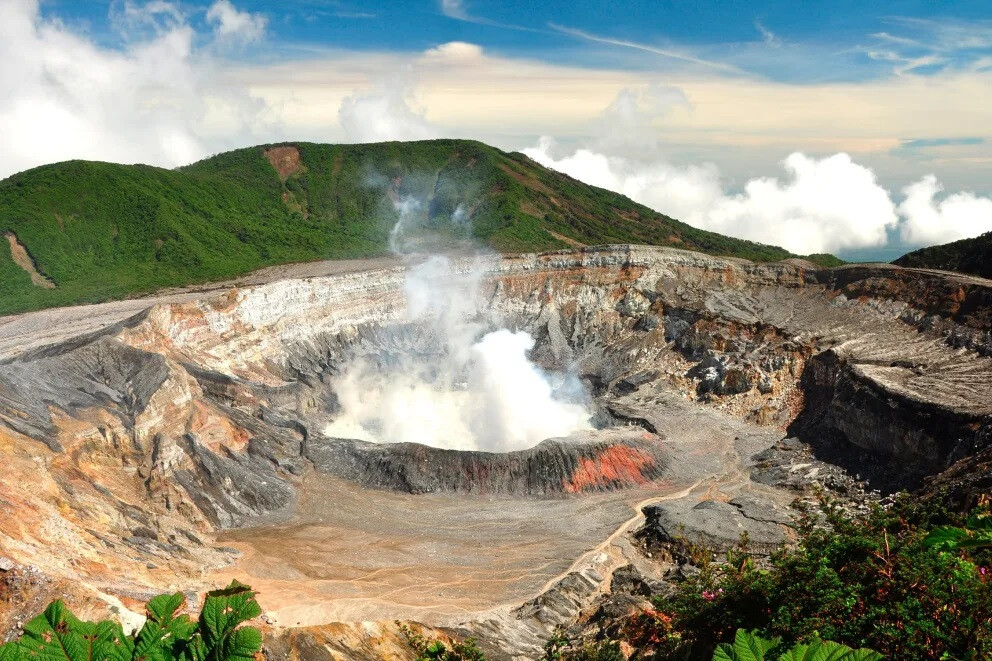
Concerns are mounting in Costa Rica as the Poás Volcano exhibits a significant increase in eruptive activity. According to the Volcanological and Seismological Observatory of Costa Rica (OVSICORI), the volcano has experienced increasingly forceful eruptions, with one recent event sending an ash column an estimated 300 meters (nearly 1,000 feet) into the sky. This followed an earlier eruption on the same day that produced a plume of gases and ash rising 200 meters above the active crater.
Experts at OVSICORI have reported continuous explosions originating from the C vent within the crater. These ongoing blasts are propelling ash-laden columns to impressive heights, reaching up to 400 meters (over 1,300 feet). Prevailing winds are carrying the ash plume southwest, resulting in a noticeable layer of fine ashfall across nearby communities.
Volcanologist Dr. Maarten de Moor of OVSICORI emphasized the sustained nature of the current activity. "What stands out is the continuity of the eruption," he stated. "There's significant activity, with a lot of energy released by explosions. We don't know how long it will last, which is a key concern for us."
Continuous monitoring of the volcano reveals no indication of a decrease in its restless behavior. Data from Wednesday, March 26, showed sulfur dioxide (SO2) emissions reaching a substantial 600 tons per day. This high level aligns with previous measurements of 691 tons recorded on March 18 and an even higher 844 tons in mid-March, underscoring a trend of significant degassing.
"The eruption is progressing continuously. We've seen no decrease in seismic activity or degassing," Dr. de Moor cautioned, highlighting the potential for a prolonged period of volcanic unrest.
In response to the escalating activity, OVSICORI has raised the alert level for Poás Volcano to Level 3, signifying a state of caution. Correspondingly, Costa Rica's National Emergency Commission (CNE) has issued a yellow alert for the Poás Volcano National Park, which has been closed to the public indefinitely. A green alert has also been activated for seven surrounding cantons: Alajuela, Poás, Grecia, Sarchí, Naranjo, Río Cuarto, and Zarcero, indicating a need for increased vigilance and preparedness in these areas. These measures follow several weeks of heightened volcanic activity that prompted officials to intensify their monitoring efforts.
The Ministry of Health has issued urgent recommendations to residents in the affected areas, emphasizing the need to remain vigilant as ashfall intensifies. The volcanic ash poses potential risks to air quality and public health. Officials have advised residents to seek medical attention at their nearest health center if they experience symptoms such as nasal congestion, cough, difficulty breathing, throat irritation, eye redness or burning, skin issues, or gastric discomfort.
As the persistent eruptions continue without a clear end in sight, authorities and scientific experts are bracing for what could be an extended period of volcanic activity at Poás, one of Costa Rica's most dynamic and closely watched volcanoes. The situation remains under close observation, with ongoing monitoring crucial for anticipating future developments and ensuring the safety of nearby populations.
Background on Poás Volcano:
Poás Volcano is a stratovolcano located in the Central Volcanic Range of Costa Rica. It is renowned for its broad, kilometer-wide crater, which often contains a hyperacidic crater lake. The volcano has a history of frequent eruptions, ranging from minor steam and gas emissions to more significant ash eruptions and even phreatic explosions (steam-driven eruptions caused by the heating and flashing of water). Its accessibility and dramatic landscape make it a popular tourist destination when it is safe to visit. The current intensification of activity highlights the inherent risks associated with living near active volcanic systems.
Potential Hazards of Volcanic Ash:
Volcanic ash, despite its fine texture, is abrasive and can cause a range of problems:
Respiratory Issues: Inhalation of fine ash particles can irritate the respiratory system, leading to coughing, sore throat, bronchitis, and difficulty breathing, particularly for individuals with pre-existing respiratory conditions like asthma.
Eye Irritation: Ash can cause redness, itching, and abrasion of the eyes.
Skin Irritation: Contact with ash can cause skin irritation and dryness.
Infrastructure Damage: Ash can accumulate on roofs, potentially causing structural collapse, especially when wet. It can also clog drainage systems and damage machinery and electronics.
Transportation Disruptions: Ashfall can reduce visibility, making driving hazardous, and can also affect air travel by damaging aircraft engines.
Agriculture Impacts: Heavy ashfall can damage crops and contaminate water sources for livestock.
Authorities are likely to continue providing updates and guidance to the public as the situation at Poás Volcano evolves. Residents in the affected areas are urged to stay informed through official channels and follow the recommendations of emergency management and health officials.
[Copyright (c) Global Economic Times. All Rights Reserved.]






























